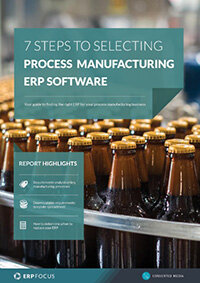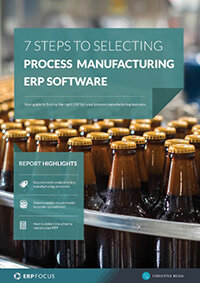11 ERP production scheduling tools that help you get jobs done
Production jobs are set up to make a finite quantity or batch of product to be sold. ERP production schedule management is a tool that keeps all these jobs moving toward on-time delivery and provides an alert when any are not on schedule. Here are eleven key features of this popular manufacturing ERP module.
1. Forward scheduling
Forward scheduling tools allow us to define a start time for the production job and ERP will calculate an estimated completion date and time. The more advanced this module is, the more variables are included in the scheduling algorithm; from available workforce to machinery occupation.
Recommend reading: 7 steps to selecting process manufacturing ERP
2. Backward scheduling
Unsurprisingly, backward scheduling tools allow us to define a completion time from which ERP will work backwards in time to determine the date and time we need to start. Again, the more advanced this module is, the more variables it will factor into calculations. What variables have the greatest impact on your production schedules?
3. Routing
This is the sequence of steps or operations needed to complete production work. ERP production modules can be programmed with template routes, schedule these routes and create inspection or quality assurance points along the sequence.
4. Resource management
Resource management covers the staff, tools, or equipment required to complete a production run. Each step in the routing can be assigned resources in and ERP production module. More advanced functionality enables these resources to be shared by other jobs to be scheduled and completed.
5. Planned quantity
Every job is planned to complete a certain number of units. When there is spoilage, ERP can allocate additional material and time to the job or adjust the job to complete with a lesser quantity.
6. Required materials
Materials needed to complete work are planned by ERP at a quantity per planned completion for the job. Those materials might all be issued at the start of the job or be issued as required by certain operations in the job.
7. Destination
Jobs are used to supply a unique customer order. A good manufacturing ERP will allow you to link a series of jobs to an order to supply demand allowing one job will feed to another. A job can also be used to supply a part to inventory. ERP can manage all these depending on the business’ requirements.
8. Finite scheduling
A fixed resource, such as a machine can only operate 24 hours in a day. Finite scheduling allows ERP to cap the scheduled load on that resource and push remaining work to the next available day.
9. Infinite scheduling
Some resources are flexible. Shop labor might be a crew of ten people. But those people can work overtime or can be supplemented by temporary workers so production ERP with infinite scheduling enabled will schedule as many hours as needed to complete jobs.
10. Shop load
This is the total number of hours required to complete work on a schedule. Any production ERP module worth its salt should track and report on this metric. Management will look at this over a single day or a range of days such as a week or month. Management can look at the entire shop or at a single resource to see different views of shop load.
11. Shop capacity
This is the theoretical amount of hours we can schedule for the entire shop or any resource. When capacity is greater than load, ERP should look for additional work to schedule. When load exceeds capacity ERP should look for work that can be rescheduled or alert users when additional work is planned.
Free white paper

7 Steps to Selecting Process Manufacturing ERP
Your guide to finding the right ERP software for your process manufacturing business

Related articles
-

How to Manage Output Capacity with Manufacturing ERP
Find out how you can implement manufacturing ERP processes which can monitor, manage and optimize...
-

CMMC Compliance: What Aerospace and Defense Manufacturers Need to Know
Key insights on CMMC compliance, deadlines, and securing DoD contracts with CMMC 2.0 certificatio...

